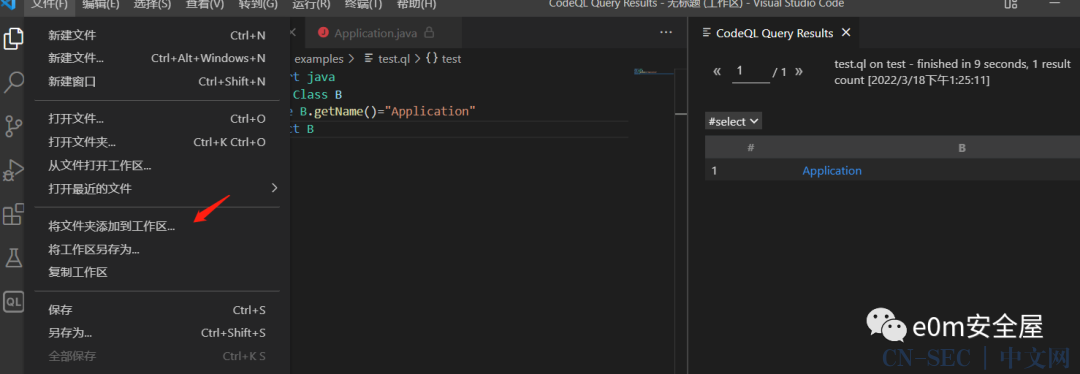首先话多两句 学习一门语言看文档是最烦的事情没有之一,但是不看文档又不能很全面的覆盖方方面面,说一下我的思路吧。啃文档恼火,但是需要结合文档的结构去确定学习的方向。对于一些生涩难懂的地方可以合理利用google去单个搜索。然后能看懂别人写的codeql查询语句后,结合别人的思路,进行学习。同时自己也去拓展不同的地方,结合起来,应该会轻松一点。有些地方具体的还未涉及,后期还会补发。
下载 codeql-cli:
https://github.com/github/codeql-cli-binaries/releases
ql库:https://github.com/github/codeql/releases
安装插件 VSCode

使用
(1)生成审计数据库 database create test --language="java" --command="mvn clean install --file pom.xml" --source-root=../seccode (2)选择合适的工作区,这里我直接引用导入的库
(3)编写合适的QL查询语句,位于qljavaqlexamples,文件命名为*.ql
(4)执行简单查询并查看结果

查询多个数据库
查看AST语法树
(1)基本语法
查询import javafrom Class Bwhere B.getName() in["Index","Login"]select Bfrom 声明变量where限制条件select 输出结果Filed 字段Method 方法Class 类名Package 包名
(2)函数(谓词)
谓词分类(1)非成员谓词 Non-member predicate(定义在class之外的谓词)(2)成员谓词 定义在class之内的谓词(3)特征谓词 可以理解为类构造方法对上面的查询更改关键词 predicate 首字母必须小写(1)这是没有类型的函数 还能利用 int,float,string等类型定义函数predicate getAllClass(Class b) {b.getName() in["Index","Login"]}from Class Bwhere getAllClass(B)select B(2)有返回值的谓词保存在result中import javaClass add(Class i ){i.getName() ="XStreamHandler" and result =i}from Class Bselect add(B)(3)当我们需要直接执行一个谓词的时候 ,可以添加一个queryquery Class add(Class i ){i.getName() ="XStreamHandler" and result =i}
(3)类
要求(1)首字母大写(2)必须继承一个类(3)关键字为class(4)this代表父类而不是本身(5)与类名相同的叫特征谓词(6)重载父类方法增加override注解import javaclass Main extends Method {Main() {this.getName()="main"}}from classGet clsselect cls类类型(1)实体类 正常定义的类(2)抽象类 abstract修饰的类
(4)方法
Method(查找存在某个方法)
parameter 函数定义变量arguement 函数传参变量获取调用参数的数量getNumberOfParameters()获取调用的制定位置参数类型method.getParameterType(0)获取超类包含子类的类型包括本身getAnAncestor ()获取超类型不包括本身getASupertype()判断存在方法名method.hasName("toObject")获取方法的类名类型method.getDeclaringType()查询某个类的某个方法method.hasQualifiedName(string package, string type)获取是否存在某个危险方法from Method methodwhere method.hasName("fromXML") and method.getDeclaringType().hasQualifiedName("com.thoughtworks.xstream", "XStream")select method,method.getDeclaringType()/*查询一个方法名为fromXML,并且方法的类为XStream*/查询所有包括子类的xx方法method.hasName("toObject") and method.getDeclaringType().getAnAncestor().hasQualifiedName("org.apache.struts2.rest.handler", "ContentTypeHandler")(包括他本身)method.hasName("toObject") and method.getDeclaringType().getASupertype().hasQualifiedName("org.apache.struts2.rest.handler", "ContentTypeHandler")(不包括他本身)
MethodAccess(查找调用了某个方法)
查找调用了方法的方法call.getMethod() = method(只能显示定义)查找调用了ContentTypeHandler的toObject方法的方法(包含子类)where method.hasName("toObject") and method.getDeclaringType().getAnAncestor().hasQualifiedName("org.apache.struts2.rest.handler", "ContentTypeHandler") and call.getMethod() = method
类型
原始数据类型 PrimitiveTypeboolean, byte, char, double, float, int, long, short非原始类型 RefType基本类型 TypeString,TypeObject、TypeCloneable、TypeRuntime、TypeSerializable类类型 Class实例 from Variable v , TypeString tswhere ts=v.getType() and ts.hasName("String")select v
适用于java的codeql
三大核心模块
DataFlow模块 数据流处理模块
Smtm模块 AST语法树模块
Expr模块 节点相关
导航调用图
callable 被调用的函数call 调用callable实例1from Call ca ,Callable cbwhere ca.getCallee() =cb and cb.getDeclaringType().hasQualifiedName("org.springframework.expression", "ExpressionParser")and cb.hasName("parseExpression")select ca解释:寻找调用了org.springframework.expression.ExpressionParser#parseExpression的地方from Call ca ,Callable cbwhere ca.getCallee() =cb and cb.getDeclaringType().hasQualifiedName("com.alibaba.fastjson", "JSON")and cb.hasName("parse")select ca解释:寻找调用了com.alibaba.fastjson.JSON的地方谓词ca.getArgument(0) 调用的第一个参数
数据流分析
DataFlow ExprNode :表达式节点
ParameterNode:参数节点
全局数据流需要继承
DataFlow::Configuration,然后重写isSource isSink方法
本地数据流
DataFlow::localFlow(DataFlow::parameterNode(source), DataFlow::exprNode(sink))
全局污点追踪,需要继承 TaintTracking::Configuration
本地污点跟踪 TaintTracking::localTaint(DataFlow::parameterNode(source), DataFlow::exprNode(sink))
可以把他理解成一个污点传播的过程,parameterNode为污点,exprNode为汇聚点
区别
本地数据流是直接的进行带入,如果是底层方法实现则不会寻找 全局数据流可以全局带入,底层也能发现,详情可以见案例SSRF的实现
净化方法(就是依据条件打断当前的污点追踪),详情见案例3
isSanitizer
强制跟踪
isAdditionalTaintStep
就是当断点打断时候,利用此方法进行强制污点跟踪,可以解决未在codeql库里面导致跟踪失败的问题,详情见案例3
案例1 java-sec-code
实例代码来自java-sec-code本地数据流(下图1)from Call ca ,Callable cb,SpringRequestMappingMethod route//引入需要的模块where ca.getCallee() =cb and cb.getDeclaringType().hasQualifiedName("com.alibaba.fastjson", "JSON")and cb.hasName("parse") and TaintTracking::localTaint(DataFlow::parameterNode(route.getARequestParameter()),DataFlow::exprNode(ca.getArgument(0)))//寻找当调用的函数为com.alibaba.fastjson.JSON#parse的位置,并且对Spring传入的request的参数进行污点跟踪,跟踪的参数节点为传入参数,跟踪的表达式节点为我们传入的fastjson的恶意触发方法啊select ca ,route.getARequestParameter() 查找结果,传入的参数全局数据流查询ssrf这里没有采用openConnection()因为它不带参数,所以使用NEW URL来替代import javaimport semmle.code.java.frameworks.spring.SpringControllerimport semmle.code.java.dataflow.TaintTrackingclass Config extends DataFlow::Configuration{Config(){this = "Config"}override predicate isSource(DataFlow::Node source){exists(SpringRequestMappingMethod SRMM | source.asParameter() =SRMM.getARequestParameter() )}override predicate isSink(DataFlow::Node sink) {exists( Call ca,Callable cb|sink.asExpr() =ca.getArgument(0) and ca.getCallee()=cb and cb.getDeclaringType().hasQualifiedName("java.net", "URL")and cb.hasName("URL"))}}from DataFlow::Node sour ,DataFlow::Node sink,Config configwhere config.hasFlow(sour, sink)select sour,sink
案例2 数据流分析CVE-2017-9805
https://blog.sometimenaive.com/2020/05/21/find-fastjson-jndi-gadget-by-codeql-tainttracking/https://github.com/githubsatelliteworkshops/codeql/blob/master/java.mdsource:toObject(in)sink:com.thoughtworks.xstream.fromXML根据分析,我们需要寻找一个污点为toObject的第一个参数为Reader,汇聚点为xstream.fromXML的一条污点传播路径代码如下import javaimport semmle.code.java.dataflow.DataFlowclass StrutsSafe extends DataFlow::Configuration {StrutsSafe() { this = "StrutsSafe" }override predicate isSource(DataFlow::Node source) {exists(Method me | me.hasName("toObject") and me.getDeclaringType().getAnAncestor().hasQualifiedName("org.apache.struts2.rest.handler", "ContentTypeHandler") and me.getParameter(0) = source.asParameter())}override predicate isSink(DataFlow::Node sink) {exists(Call call, Callable method | method.hasName("fromXML") and method.getDeclaringType().hasQualifiedName("com.thoughtworks.xstream", "XStream") and call.getCallee() = method and sink.asExpr() = call.getArgument(0))}}from StrutsSafe stu, DataFlow::Node source, DataFlow::Node sinkwhere stu.hasFlow(source, sink)select source,sink
案例三
https://www.freebuf.com/articles/web/283795.html(1)分析sql注入,我们发现最终是利用jdbcTemplate.query()也就是query()方法触发,所以我们可以定义query()为汇聚点,污点为我们传入的参数。import javaimport semmle.code.java.dataflow.FlowSourcesclass SqlConfig extends TaintTracking::Configuration {SqlConfig() { this = "SqlConfig" }override predicate isSource(DataFlow::Node source) {source instanceof RemoteFlowSource}override predicate isSink(DataFlow::Node sink) {exists(Method me ,MethodAccess ma | me.hasName("query") and ma.getCallee() = me and sink.asExpr() = ma.getArgument(0) )}}from SqlConfig scg ,DataFlow::Node source, DataFlow::Node sinkwhere scg.hasFlow(source, sink)select source.toString(),source,sink
为了消除上面关于数值类型的注入误报,我们加入isSanitizer来进行污点误报解决,判断当污点为数字类型就断掉import javaimport semmle.code.java.dataflow.FlowSourcesclass SqlConfig extends TaintTracking::Configuration {SqlConfig() { this = "SqlConfig" }override predicate isSource(DataFlow::Node source) {source instanceof RemoteFlowSource}override predicate isSink(DataFlow::Node sink) {exists(Method me ,MethodAccess ma | me.hasName("query") and ma.getCallee() = me and sink.asExpr() = ma.getArgument(0) )}override predicate isSanitizer(DataFlow::Node node) {node.getType() instanceof PrimitiveType ornode.getType() instanceof BoxedType ornode.getType() instanceof NumberType orexists(ParameterizedType pt| node.getType() = pt and pt.getTypeArgument(0) instanceof NumberType )}}from SqlConfig scg ,DataFlow::Node source, DataFlow::Node sinkwhere scg.hasFlow(source, sink)select source.toString(),source,sink
为了消除不可识别类型对codeql分析的影响,我们加入isAdditionalTaintStepimport javaimport semmle.code.java.dataflow.FlowSourcesclass SqlConfig extends TaintTracking::Configuration {SqlConfig() { this = "SqlConfig" }predicate isTaintedString(Expr expSrc, Expr expDest) {exists(Method m ,MethodAccess ma1,MethodAccess ma2 | expSrc = ma1.getArgument(0) and expDest = ma2 and ma2.getMethod() =m and m.hasName("get"))}override predicate isSource(DataFlow::Node source) {source instanceof RemoteFlowSource}override predicate isSink(DataFlow::Node sink) {exists(Method me ,MethodAccess ma | me.hasName("query") and ma.getCallee() = me and sink.asExpr() = ma.getArgument(0) )}override predicate isSanitizer(DataFlow::Node node) {node.getType() instanceof PrimitiveType ornode.getType() instanceof BoxedType ornode.getType() instanceof NumberType orexists(ParameterizedType pt| node.getType() = pt and pt.getTypeArgument(0) instanceof NumberType )}override predicate isAdditionalTaintStep(DataFlow::Node node1, DataFlow::Node node2) {isTaintedString(node1.asExpr(), node2.asExpr())}}from SqlConfig scg ,DataFlow::Node source, DataFlow::Node sinkwhere scg.hasFlow(source, sink)select source.toString(),source,sink/**这个isTaintedString意思就说我们对get表达式节点进行了一个结合,但是由于没有做类型限制,所以会查出来比较多的数据,我们精确一下将参数和方法的类型做一个精确**/import javaimport semmle.code.java.dataflow.FlowSourcesclass SqlConfig extends TaintTracking::Configuration {SqlConfig() { this = "SqlConfig" }predicate isTaintedString(Expr expSrc, Expr expDest) {exists(Method m ,MethodAccess ma1,MethodAccess ma2 | expSrc = ma1.getArgument(0) and expDest = ma2 and ma2.getMethod() =m and m.hasName("get") and m.getDeclaringType().toString()="Optional<String>" and ma1.getAnArgument().getType().toString()="Optional<String>")}override predicate isSource(DataFlow::Node source) {source instanceof RemoteFlowSource}override predicate isSink(DataFlow::Node sink) {exists(Method me ,MethodAccess ma | me.hasName("query") and ma.getCallee() = me and sink.asExpr() = ma.getArgument(0) )}override predicate isSanitizer(DataFlow::Node node) {node.getType() instanceof PrimitiveType ornode.getType() instanceof BoxedType ornode.getType() instanceof NumberType orexists(ParameterizedType pt| node.getType() = pt and pt.getTypeArgument(0) instanceof NumberType )}override predicate isAdditionalTaintStep(DataFlow::Node node1, DataFlow::Node node2) {isTaintedString(node1.asExpr(), node2.asExpr())}}from SqlConfig scg ,DataFlow::Node source, DataFlow::Node sinkwhere scg.hasFlow(source, sink)select source.toString(),source,sink
原文始发于微信公众号(e0m安全屋):codeql 学习笔记1
- 左青龙
- 微信扫一扫
-

- 右白虎
- 微信扫一扫
-














评论